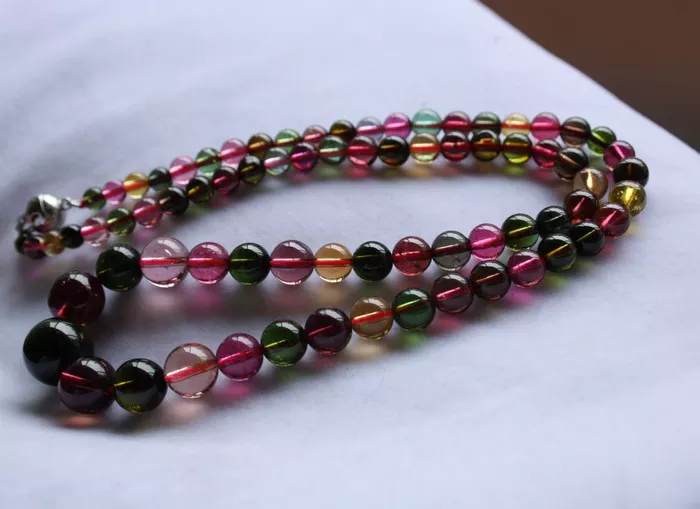Black tourmaline, known for its striking dark color and powerful metaphysical properties, has gained popularity as a sought-after crystal in the world of gemstones. However, with its growing demand, the market has seen an influx of counterfeit and synthetic replicas. Distinguishing genuine black tourmaline from imitations is crucial for those seeking the true energetic benefits this stone offers. In this article, we will explore various methods to determine the authenticity of black tourmaline and ensure you are acquiring a genuine specimen.
Understanding Black Tourmaline
Before delving into identification techniques, it is essential to familiarize oneself with black tourmaline’s characteristics. Black tourmaline, also known as schorl, is a mineral belonging to the tourmaline family. It is typically opaque and occurs in various shades of deep black.
Natural black tourmaline frequently exhibits striations or grooves running parallel to its long axis. These striations can appear as thin lines or ridges across the surface of the crystal. Additionally, black tourmaline often forms prismatic crystals with triangular cross-sections and vertical striations. Understanding these attributes will aid in identifying genuine black tourmaline specimens.
Visual Examination
The first step in determining the authenticity of black tourmaline involves careful visual inspection. Examine the stone under good lighting conditions and observe its physical properties closely.
Color:
Genuine black tourmaline displays a rich, deep black hue that is consistent throughout the crystal. Be wary of stones that appear unusually shiny or exhibit a different shade of black, as these may be signs of imitation.
Transparency:
Black tourmaline is generally opaque. If you notice transparency or translucency in the crystal, it is likely a different stone or a dyed black tourmaline.
Striations:
As mentioned earlier, genuine black tourmaline often exhibits parallel striations or grooves running along its length. Carefully examine the surface of the crystal to identify these characteristic markings.
Luster:
Black tourmaline has a vitreous to resinous luster. It may appear slightly dull or matte due to its natural texture. Synthetic or imitation stones may have a glassy or overly polished appearance.
Physical Properties Assessment
Apart from visual examination, evaluating the physical properties of black tourmaline can provide further insight into its authenticity.
Hardness:
Black tourmaline has a hardness of 7 to 7.5 on the Mohs scale. It is relatively scratch-resistant and should not easily be scratched by common objects like fingernails or coins. Conduct a simple hardness test by attempting to scratch the stone with various materials, keeping in mind that harder substances can still scratch softer stones.
Weight and Density:
Natural black tourmaline possesses a specific gravity ranging from 3.06 to 3.25. Comparing the weight of the stone to its volume can help determine if it falls within this range. If the specimen feels exceptionally light or heavy, it might indicate an imitation or a different material altogether.
Cleavage and Fracture:
Black tourmaline exhibits imperfect to no cleavage, meaning it does not split easily along flat planes. Instead, it tends to fracture unevenly with a conchoidal (shell-like) pattern. Synthetic or fake tourmalines may have more regular cleavage or exhibit different fracture patterns.
Special Tests for Authenticity
In addition to visual and physical examinations, there are a few special tests that can aid in verifying the authenticity of black tourmaline.
UV Fluorescence:
Genuine black tourmaline typically fluoresces under ultraviolet (UV) light. Using a UV light source, examine the stone to check for a distinctive fluorescence response. Natural black tourmaline often exhibits a green or blue glow, while imitations may show little to no fluorescence.
Thermal Conductivity:
Black tourmaline possesses unique thermal properties that can be detected using a thermal conductivity meter. Genuine black tourmaline tends to exhibit lower thermal conductivity compared to most imitations and synthetics. While this test is not easily accessible to everyone, it can provide valuable insights if available.
Infrared Spectroscopy:
Infrared spectroscopy can be employed to analyze the crystal lattice structure of black tourmaline. This method requires specialized equipment and is typically used by gemological laboratories. It can effectively identify any synthetic or treated gems by analyzing their molecular composition.
Consulting Professionals
If you are uncertain about the authenticity of your black tourmaline specimen, it is advisable to consult an experienced gemologist or a reputable gemstone expert. These professionals have the knowledge and tools to perform comprehensive tests and offer accurate assessments.
When purchasing black tourmaline, it is essential to ensure you are dealing with a trustworthy and reputable seller. Research the seller’s reputation, read customer reviews, and inquire about their sources of black tourmaline. Reputable sellers will often provide information about the stone’s origin and any certifications or guarantees of authenticity.
In conclusion
Determining the authenticity of black tourmaline requires a combination of visual examination, assessment of physical properties, and potentially specialized tests. Pay close attention to the stone’s color, transparency, striations, and luster. Evaluate its hardness, weight, density, cleavage, and fracture patterns. Consider conducting special tests such as UV fluorescence, thermal conductivity, or infrared spectroscopy if available.
If you are still uncertain after conducting these tests, it is best to seek the expertise of a professional gemologist or gemstone expert who can provide accurate assessments and guide you in making an informed decision.
By following these guidelines and taking the necessary precautions, you can confidently identify and acquire genuine black tourmaline, ensuring that you harness its true energetic properties and enjoy its beauty for years to come.


